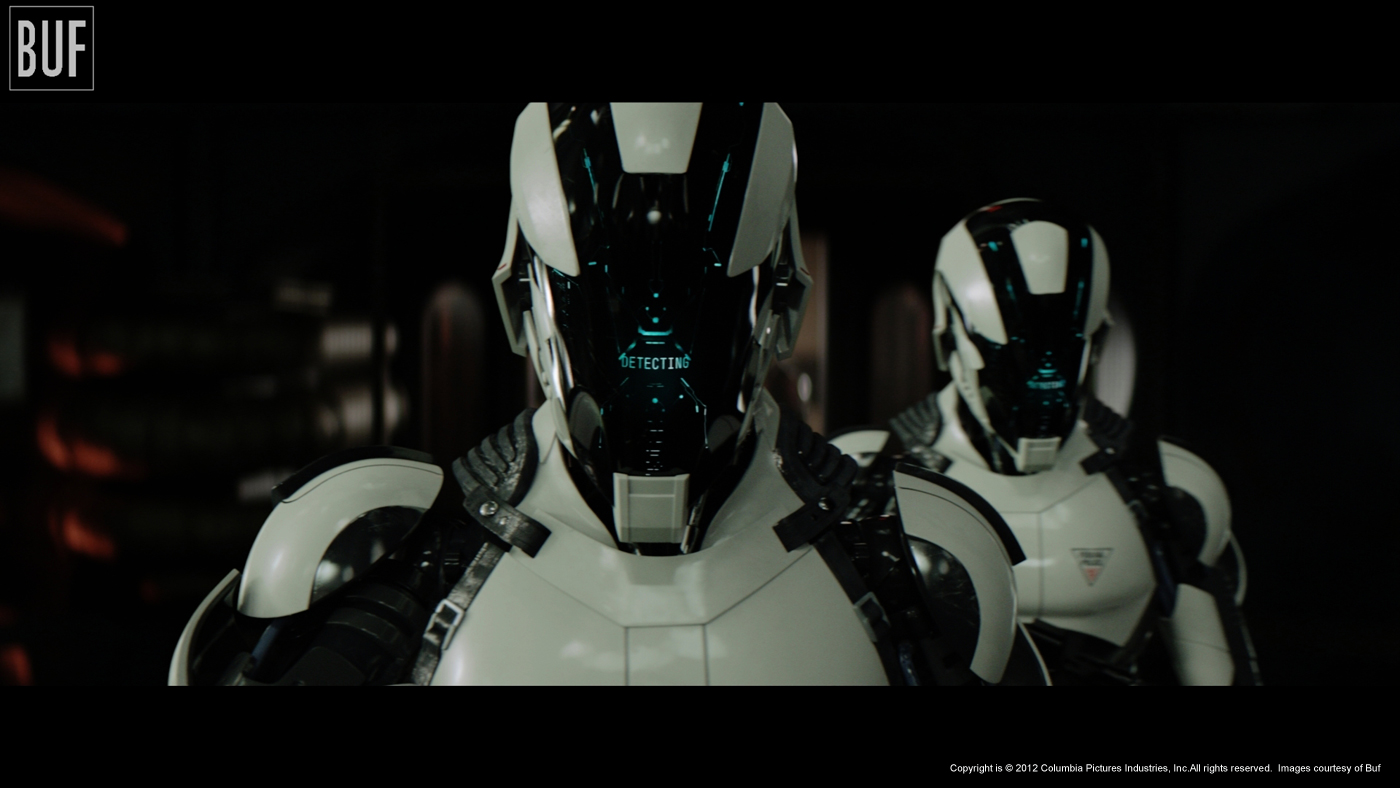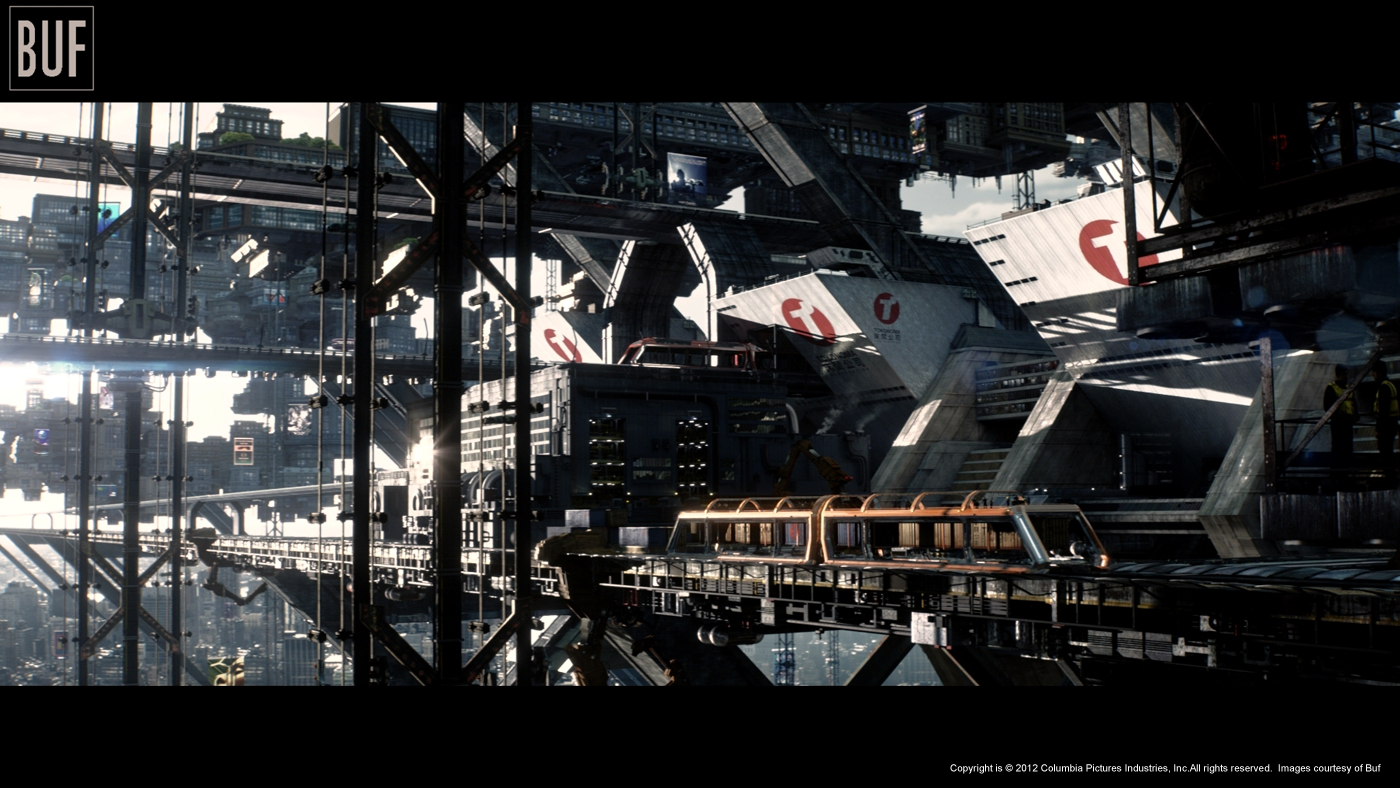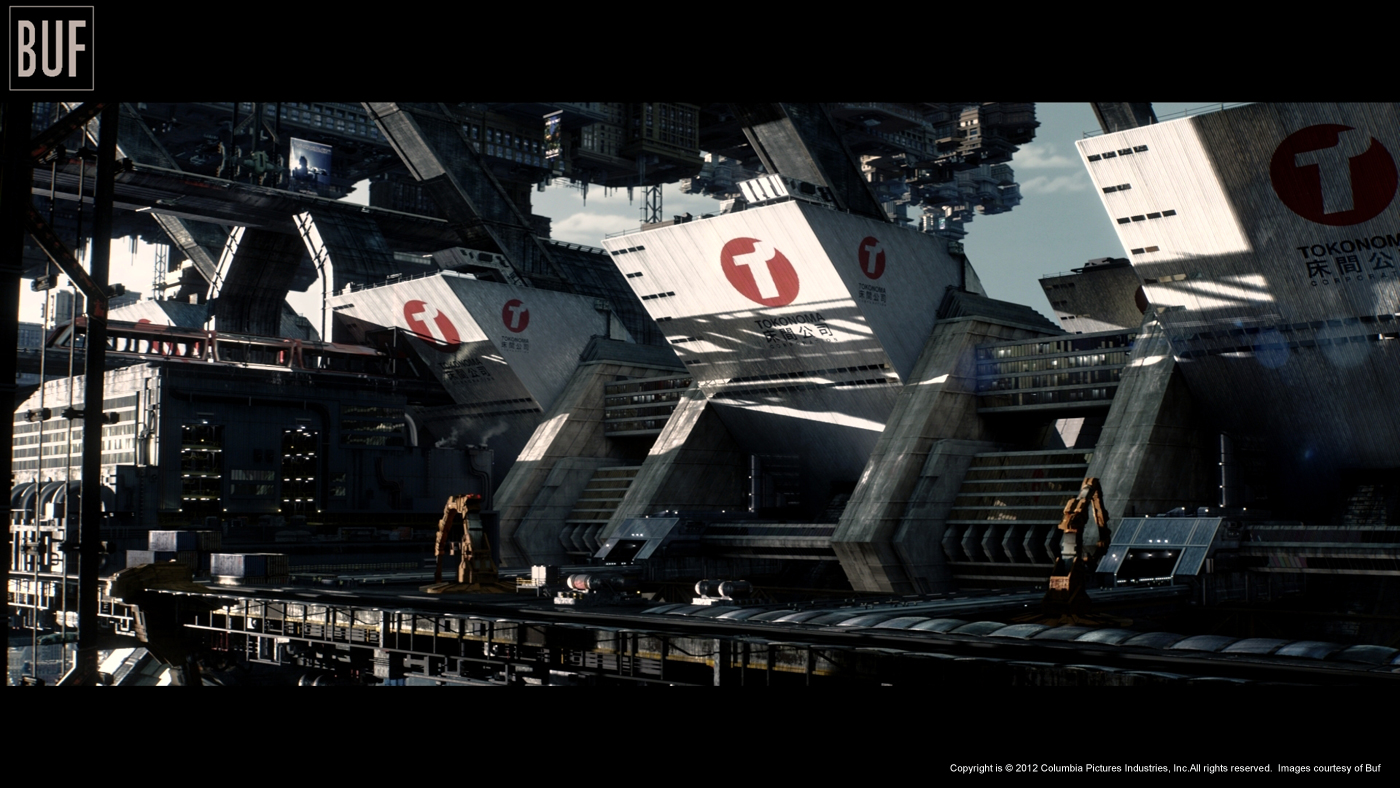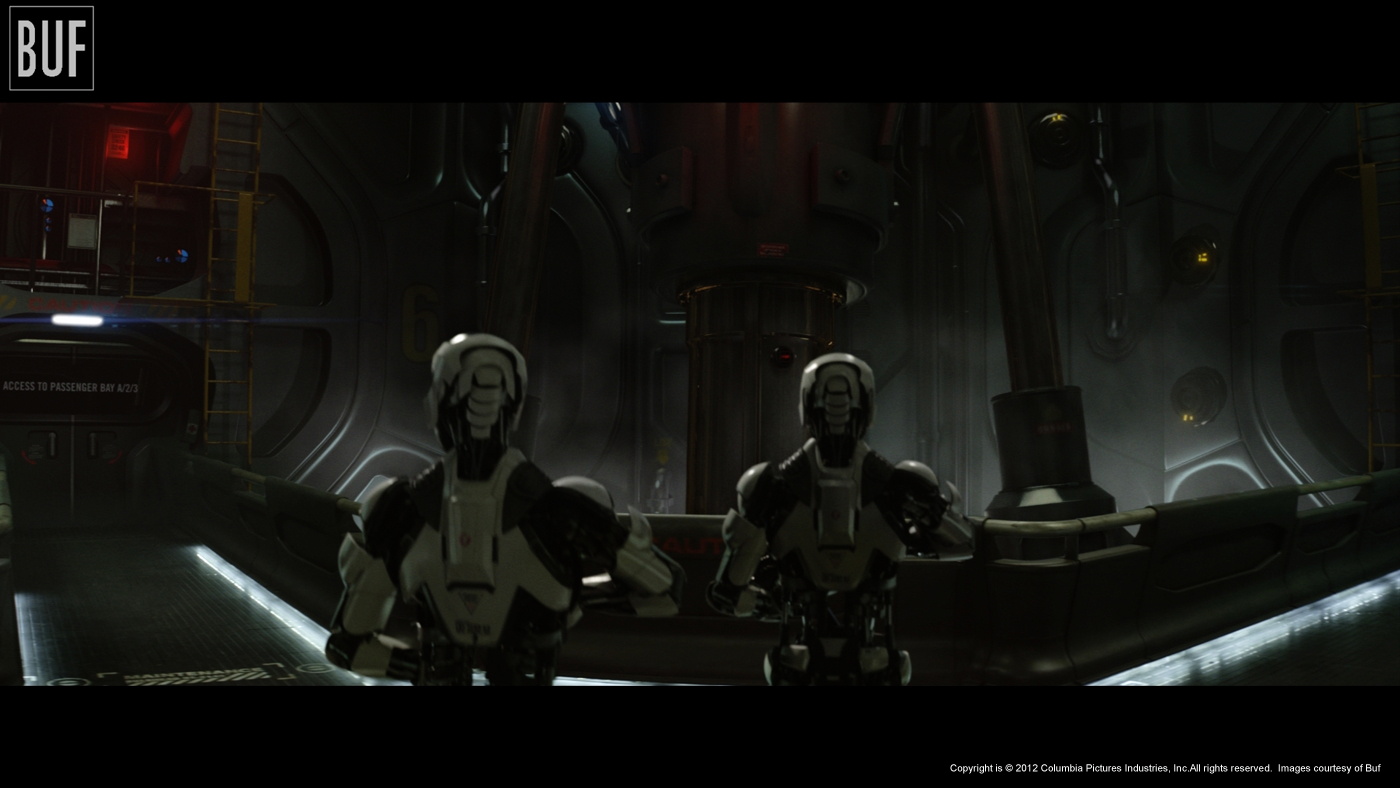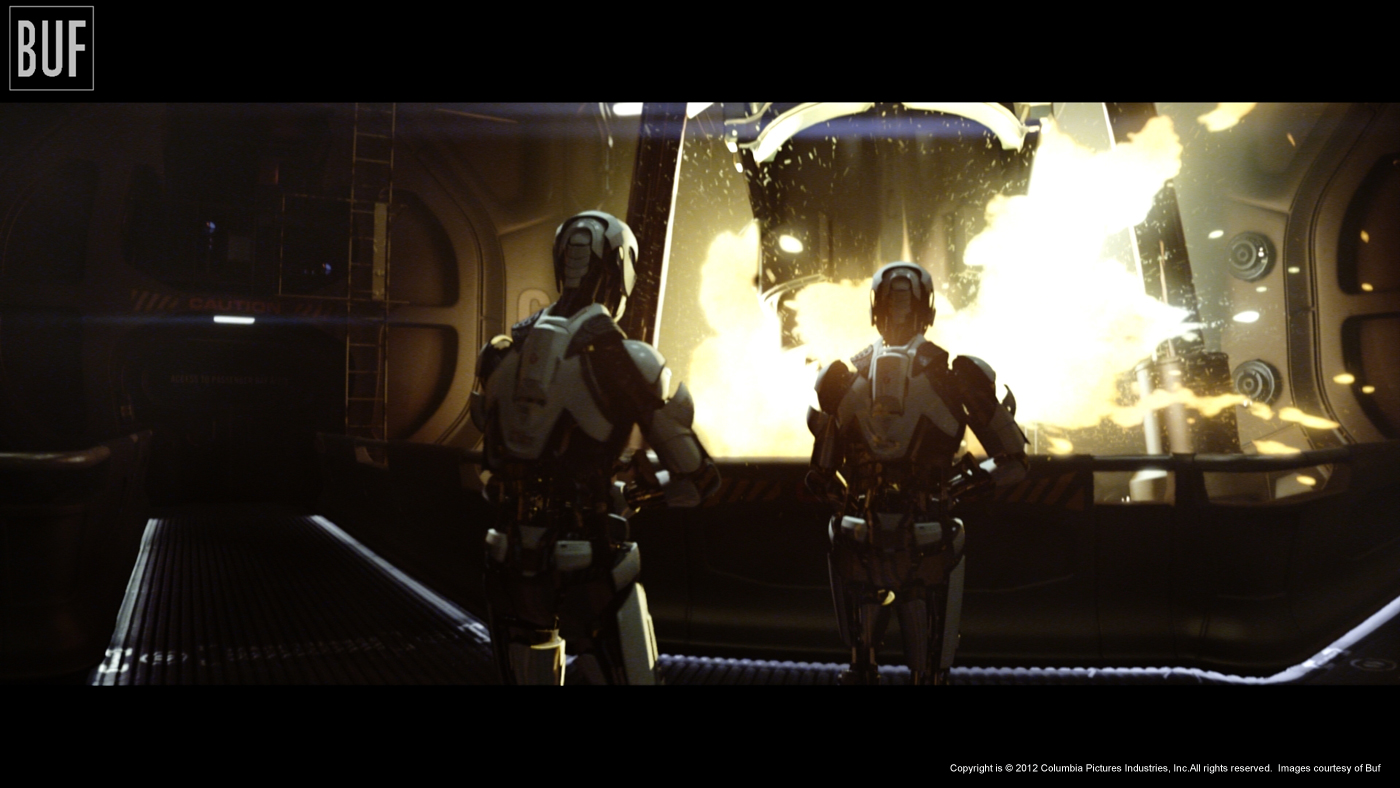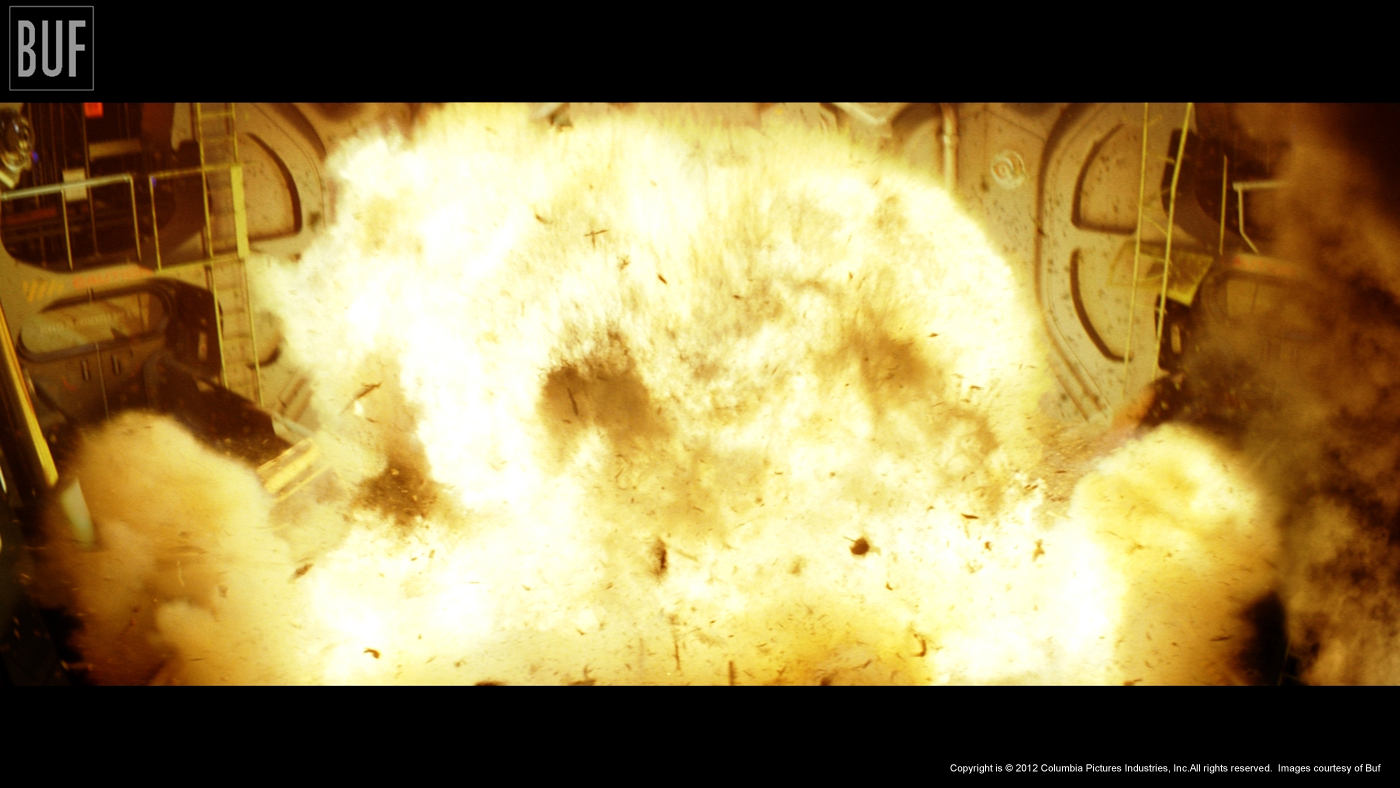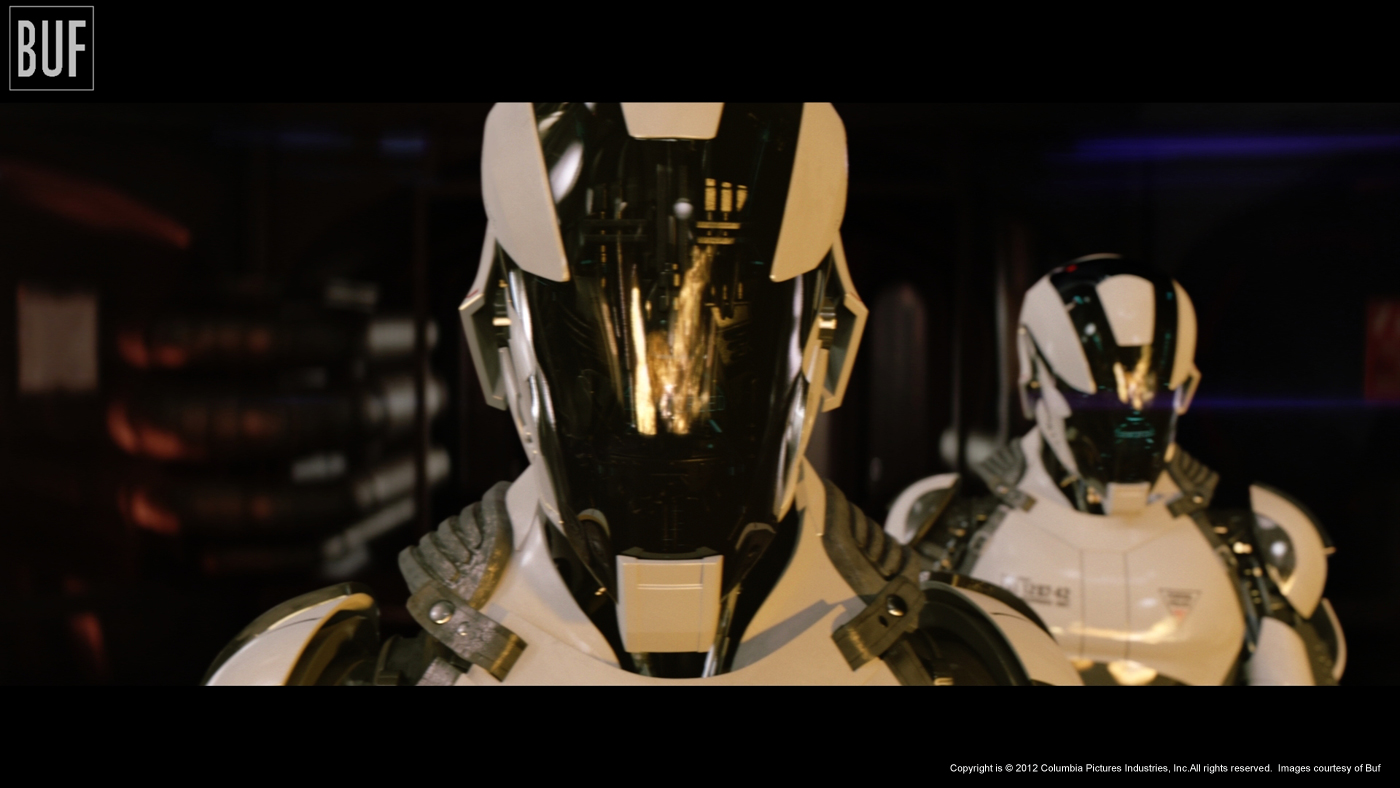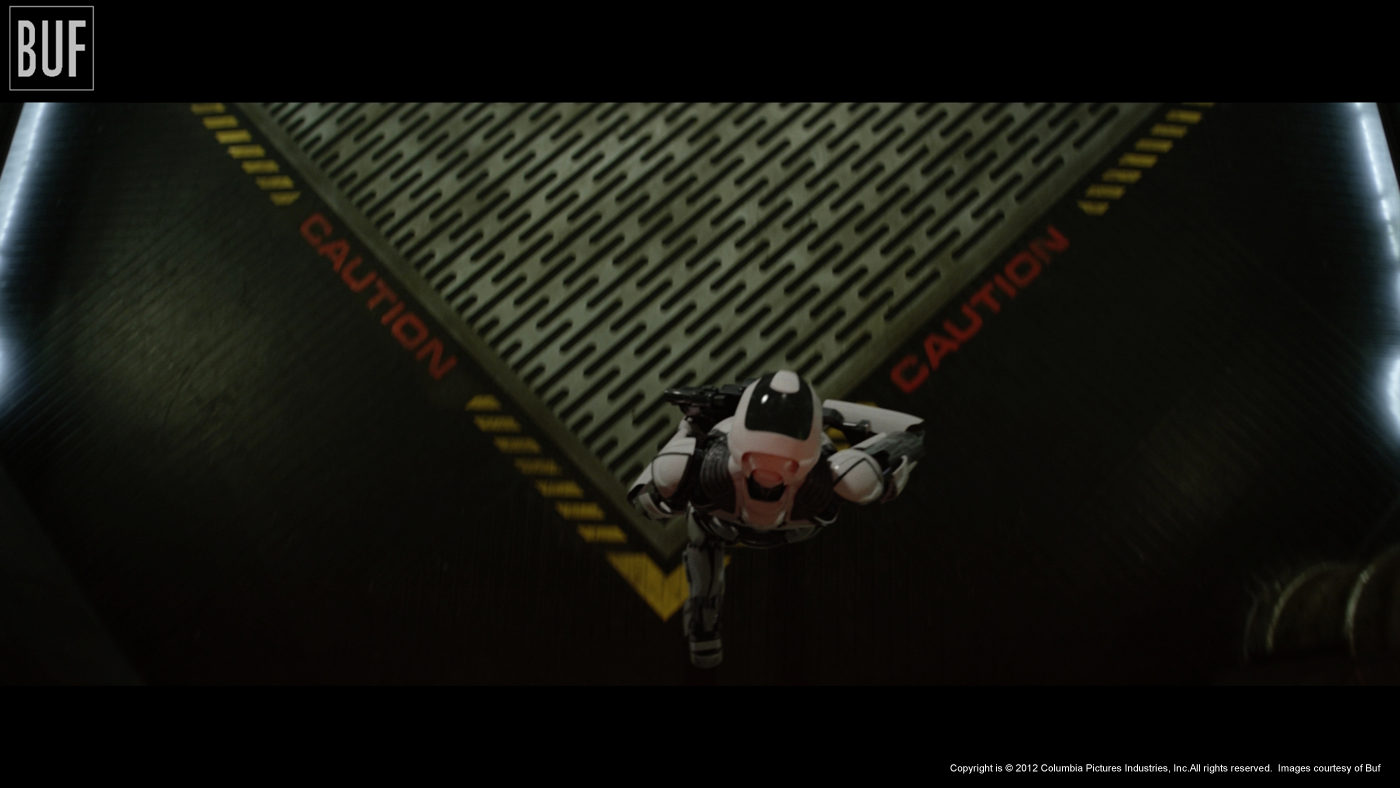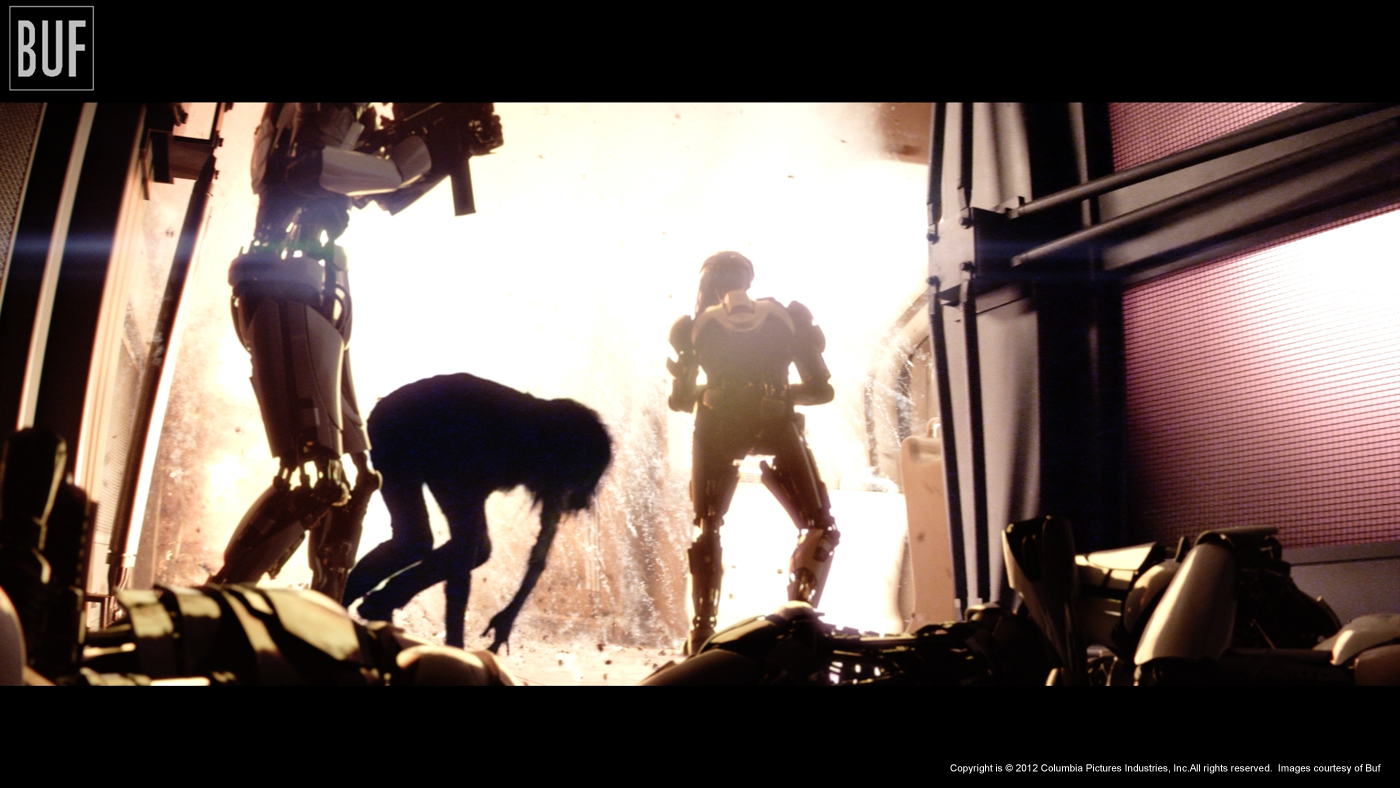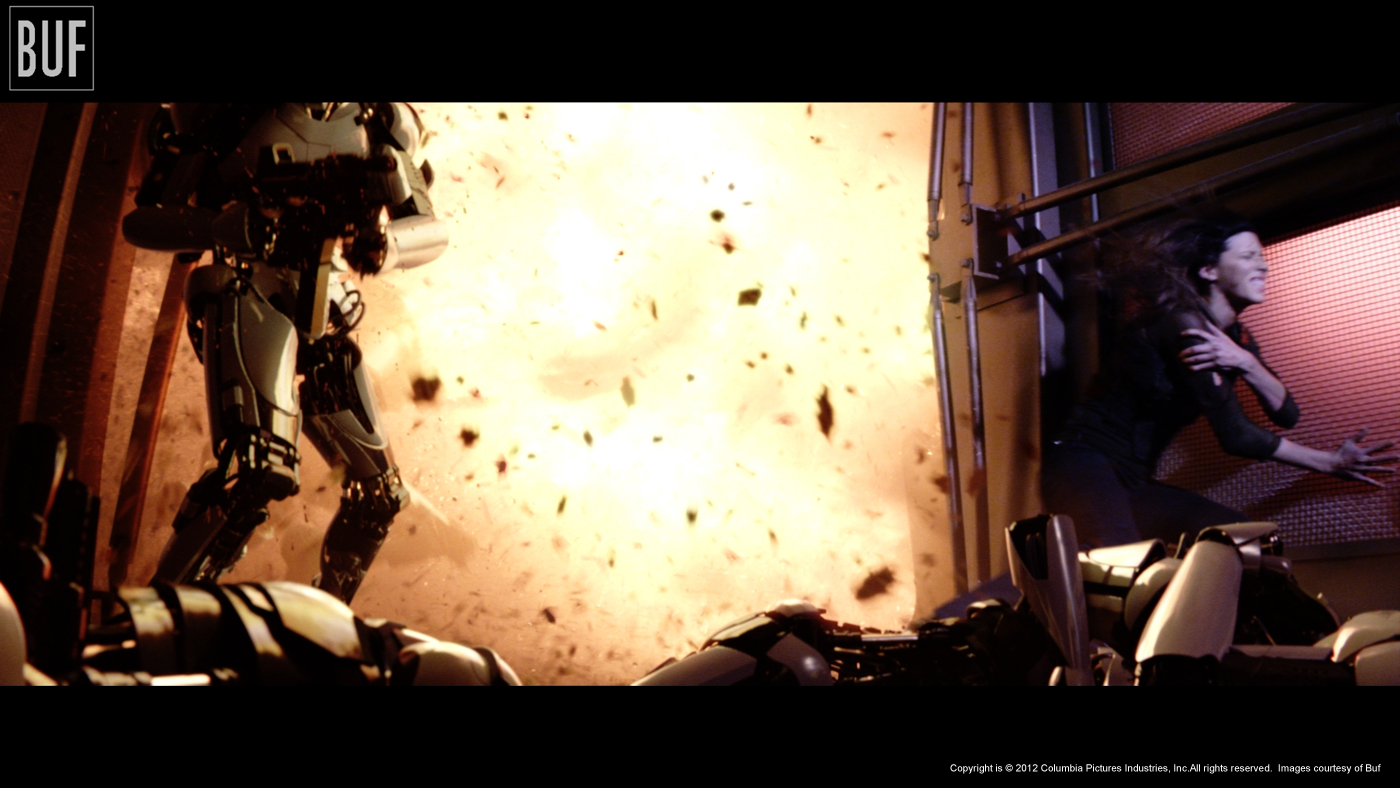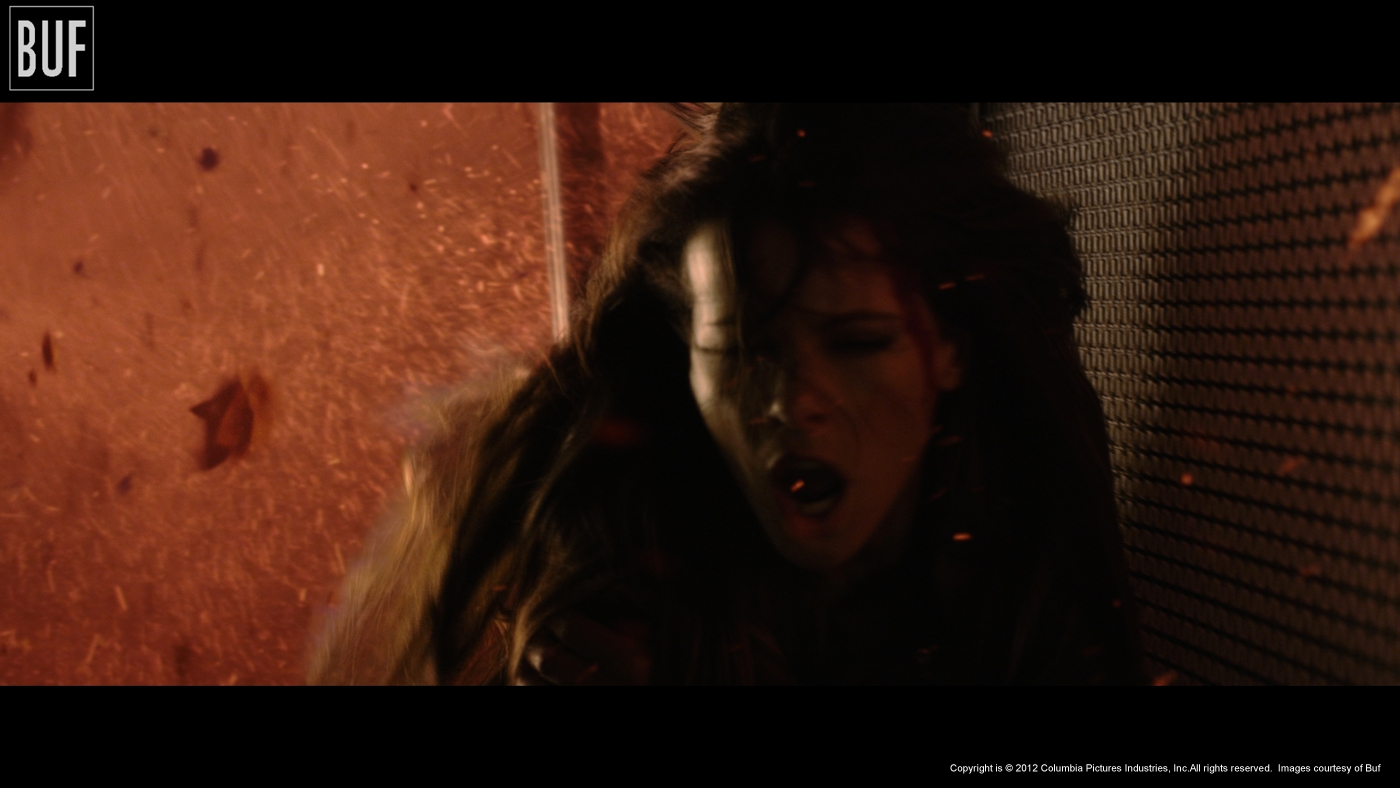Olivier Cauwet is back on The Art of VFX. After explaining the challenges for SUR LA PISTE DU MARSUPILAMI, Olivier explains his work on the remake of TOTAL RECALL.
How did BUF got involved on this show?
Due to a large number of VFX, all as complex as each other, and a deadline fast approaching, the production of TOTAL RECALL began looking for outside help to finish the film on time.
Around mid-May 2012, BUF was contacted to make a full CG shot of the outside of the « UFB Factory », where the character of Colin Farrell « Douglas Quaid » is working.
Len Wiseman, the director, was not entirely satisfied with the aspect took by the shot. Speaking to BUF, he wanted different research and other design proposals for the « UFB Factory ». We were, at that time, 6 weeks of the official end of the post-production of the film.
How have you collaborated with director Len Wiseman and Production VFX supervisor Peter Chiang?
As the others VFX companies, some VFX supervisors were also called in reinforcements. And Angus Bickerton, with which we had to work on Tim Burton’s latest film, DARK SHADOWS, joined the team of TOTAL RECALL on the end. We worked primarily with him. He was the link between the director Len Wiseman and BUF.
Angus was in London, at the heart of the post-production of the film. So we communicate in video conferencing sessions and did Cinesync once per day at the beginning, and because of the short time, we quickly went to two sessions per day. We wanted to share a maximum with Angus. As we arrived during the production, not to say at the end of it, and that everything was already established such as the designs, atmospheres, we have to quickly fit inside it. Angus showed us some VFX shots in « work in progress » to immerse ourselves in the world of TOTAL RECALL, our work need to fit perfectly with the other companies.
Angus is always a positive supervisor, who wants to explore all the possibilities that it offers with a shot, which is exactly our mindset. This is why we have so many exchanged, we did a lot of testing proposals and despite the time, this is what Angus expected from BUF.
What BUF did on this film?
BUF had a variety of effects work on 17 shots in the film.
So there was this full CG shot outside the « UFB Factory », an establishing shot about 6 seconds, with the city in the background, highways, cars, cargo train, workers, and of course the factory itself to create.
We have created full CG set extensions of the engine room, that need to fit with those of Double Negative, for close-ups shots where Douglas Quaid poses bombs.
We worked on a sequence in which the robot soldiers « Synths » are destroyed in a series of explosions. It included work staging, animation, extending the engine room set, some SFX, Synths compositing and integration of several elements such as explosions and actress Kate Beckinsale.
In this sequence we could have close-ups shots of Synths, a wide shot with set extension in which they are walking, some shots where 10 Synths are destroyed by explosions in the hallway, others shots in which we need to incorporate the full CG set behind the explosion of the engine room, and the shots in which we have to add Kate Beckinsale in the middle of the explosion with additions of SFX.
We had a shot in the sequence of the « China Fall »destruction with the integration of a full CG set seen from the outside through the window being destroyed in the rain, with lightning, CG debris, sparks, etc.. Then we received shots with Synths to animate and integrate into the hallway, a dead Synth on the ground, additions of flames in the background and coals of fire in the air, because we are just after the explosions.
Finally, we also had to take Kate Beckinsale from a shot and put her in another sequence where she was not expected during the shooting. Following a change of scenario at the editing, we had to create two shots in which the actress must be present. This involved hard work on the background and compositing Kate Beckinsale.
All these shots were added during our schedule of 6 weeks of work.
Can you tell us in detail the establishing shot of the UFB Factory?
When we started this shot, Dneg had already made a 2D rough model of the establishing shot of the UFB factory, but Len Wiseman was not satisfied with the design. We had to propose a new concept for the factory. Given the time, Yoel Godo team immediately started in 3D. We quickly made several proposals for the factory with simple templates and various proposals for the composition of the shot. Angus Bickerton give us feedbacks about what Len did not want, such as do not have too much sky, the city with its clusters of buildings would cover more, not colored brick for buildings, etc.
In parallel with the research, the team was modeling in detail the elements already approved by Len. Road and rail structures, the « stanchions », these pillars that support high buildings blocks, details like cables, fans, piping systems and a lot of things that we dispatched on buildings and structures that we modeled. Finally the design of the factory was quickly clarified through discussions with Angus and Pierre Buffin. We have therefore modeled in detail the structure defined, and once everything was generally approved, design, composition, camera movement, we started the mapping of the elements of the shot.
For the background, we used for the lower city some pictures of New York, and for the upper town we created apartment blocks with greenery and ads in 3D. Dneg provided us with models of buildings, but without shaders or textures. We have therefore arranged these to compose the background, and then we mapped these. Angus showed us regular « work in progress » of the city to soak up the atmosphere, a city always wet as if he had just rained, and dense where we see little sky, a structure of buildings very rich with a suspended road that runs in the heart of the city. The « elevator cars » that connect the layers of the city, cool colors, a dominant blue gray and high contrast.
It’s a wide shot, the structures are so huge that it is difficult to get a sense of scale. It was one of our main concerns to find visual cues. For example, we disposed of 3D workers on the side of the cranes, on gateways, and put containers in cargo train. We modelised a foreground on which we put extras filmed on green screen. It was for each plane in depth, to find a visual cue that gives an idea of the scale. To add to the amount of detail in the shot, we animated CG characters, cars above and below the road networks, which deploy cranes, trains run, the « elevator cars » down, workshops activate the factory, etc..
For the light, Raphel Zito took care of the lighting, for the sun, and the ambient light, we used global illumination. For the light play, he placed and animated a multitude of small lights in the factory and in all areas of activity. To stay very reactive with this shot, which became increasingly complex, we have optimized the renders. We cut the shot into several layers in depth, and all elements were rendered during the night, which allowed us to show a new version with the last comments each day. We have presented 34 versions of this shot to Angus Bickerton.
How did you create the set extensions for the Engine Room?
It is a set that was shared by Dneg, we recovered the modeling of the engine room with its maps, but the shaders are proprietary of Dneg. So we imported these into our software « bstudio ». We have not changed it, we just found back the shaders and lights by studying the other shots of the film where Douglas Quaid is in this scene.
How were the collaboration and exchange of assets with Double Negative?
Good, but the Dneg department that dealt the databases exchange was very busy at the end of the project, so we received the items as you go. We had to manage the project with these deadlines.
We received a maya scene, fbx exports and the textures in Tiff format for the sets and the synths. To overcome the lack of information for the shaders, we have agreed to receive « json » files that script the connections of the textures to shaders, and shaders to the objects.
BUF uses proprietary software. Does it this caused you some trouble for the recovery of Double Negative assets?
Not really, it asked us some work, but eventually even if we had worked on maya, we would not have been faster on the recovery of the assets. We realize through the various projects we have had discussions that companies still use plugins developed internally or purchased. So we always have constraints and information gaps. On this project, we could not retrieve the shaders because they were owners Dneg, internal development certainly.
And as we could not get the setups of Synths, Dominique Vidal was in charge to recreate them in « bstudio » within a incredibly short schedule. Then Dominique with Christophe Zito have to recover the sets in « low def » to divide them into « Catmull-Clark » and analyzed the « json » file to connect properly BUF shaders and Dneg textures to the objects. A hell of a scripts job.
Can you explain the explosions creation in the Engine Room?
The explosions were filmed in the pieces of the engine room set. We have done a great job of matte because we had to extend the set in CG. Rather than light connecting different pieces of CG sets, we decided to replace everything. We animated the lights to be synchronized with the explosion, and we adjusted the frame colorimetry of high and low lights of the CG set. The explosion was filmed « underexposed » to get all the details in the highlights. When it explodes, it flashes the film off in the low lights.
To improve the integration between the explosion and the set we added CG sfx around, and also a blast to make it visually more powerful, some debris, and animated the pistons to simulate the effect of the blast.
BUF has also worked on the famous synths. Can you explain to us more detail of this aspect?
Yes, I like the design, it reminds me the « stormtrooper » look. Firstly as I said before, we had to do the setup, adapting the low, medium and high versions of the modeling to optimize the shots. The biggest challenge was to be have the same look with the others shots of the film. We had to redo the shaders with our eyes. Angus Bickerton sent us shots of CG Synths and real Synths filmed as references.
David Verbecke has done a great job, he worked shaders and setting textures of our Synths and their integration into the shots of the engine room. For lighting, we used a hdri map. The rehabilitation map was worked to well draw the volumes of the robot.
There was also a lot of work on staging and animation, the shots included at least two to ten Synths in the frame. This part took a lot of energy to find the animation style of the robots. We need to carefully examine the shots we had for reference. As we had to find the staging and composition plans, we did a lot of versions. The animation team led by Bastien Laurent has done an amazing job, they were never short of breath despite the many changes and feedbacks.
What did you received from the production to ensure Synths consistency between your shots and those of other studios?
Most often, we refer to shots of the film.
Can you tell us more about the compositing of the shots of Kate Beckinsale amidst explosions of the Engine Room?
She was filmed on a green screen, we used a explosion pass in the set of the hall as background. To help integration, we added sfx around it, the embers which pass in front of and behind the debris were CG.
How did you create the many SFX elements for these shots?
Based on particles for embers and smoke fluids. Debris are managed dynamically, gravity, collisions and obstacles, etc.. For the flames, they are in-house stock shots.
Is there an invisible shot that you would like to reveal the secret?
Following a change of scenario, we had to integrate Kate Beckinsale in a sequence where she was not expected during the shooting. She appears in two shots, that we have to recreated entirely.
Firstly, we received a render from Dneg for the set and the helicopter. We have integrated extras on a green screen, animated and lit a troop of ten walking Synths, all those in connection with the backgrounds of the sequence. Then we extract the actress from another film shot. Of course, the background does not lend itself at all to an extraction of Kate’s hair because it was tonal. Being against the light, it raised all the little details of the hair, adding to the difficulty.
A quick test extraction reinforced our idea that it would not be a success, it could only sizzle when she turns her head. So we rotoscope the face and the hair volume of Kate Beckinsale in 3D in order to hang the hair in CG and in map for the color and the mask. We have redone the edges of the hair with all its details and small hair. It is also a laborious compositing job but it gives a good result.
Have you developed new tools for this project?
Nope, no one.
What was the biggest challenge on this project and how did you achieve it?
We need to build and grow the team as the number of shots was constantly growing. Whatever the date a shot we were given to us, the deadline remained the same. Originally we were only contacted for the establishing shot. We therefore had to be extremely responsive to keep the team active and to organize everything. This type of project, complex and with an emergency deadline, is possible only with a great production and internal organization.
Was there a shot or a sequence that prevented you from sleeping?
These are not the shots that have prevented me from sleeping, it was the short deadline, no time to sleep.
What do you keep from this experience?
It was exciting, even a radically different experience. Physically demanding, but once finished, you forget this aspect. The context of the production does not give you the time to think too much, to ask you too many questions, it is necessary to make wise choices and go forward with your team.
The success of this project is also beside the talented designers, the BUF producers work, Fabrice Meunier and John Lett with whom we considered, planned and set up the team.
How many shots have you done?
17 shots.
How long have you worked on this film?
6 weeks.
What is your next project?
Nothing definite yet.
A big thanks for your time.
// WANT TO KNOW MORE?
– BUF: Official website of BUF.
// CREDITS
Visual Effects Supervisor
Olivier CAUWET
Yoël GODO
Visual Effects Producers
Fabrice LETT
John MEUNIER
Graphic Artists
Arnaud ALLENET
Fredéric BARBE
Romain BAVENT
Thomas BERKANE
Stéphane BOURDAGEAU
Julien BUISSERET
Nicolas CANDIDO
Fabrice CAUSSAT
Justine DEMOULIN
Audrey HENNETON
Bastien LAURENT
Cédric LECOMTE
Renaud LOUVET
Pierrick MAHIEU
Nicolas MAILLARD
Clémént RICHARD
Romain RICO
Jérôme ROUVELET
Lucas SALTON
David VERBEKE
Sébastien VERGNON
Dominique VIDAL
Raphaël ZITO
Christophe ZITO
© Vincent Frei – The Art of VFX – 2012



